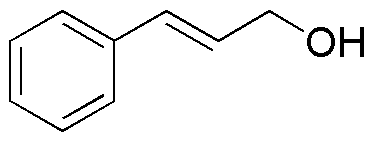Cinnamyl alcohol is widely utilized in research focused on various applications across different industries:
- Fragrance Industry: It is a key ingredient in perfumes and scented products due to its pleasant, sweet, and spicy aroma, enhancing the overall fragrance profile.
- Flavoring Agent: Commonly used in food products, it adds a unique flavor to candies, baked goods, and beverages, making them more appealing to consumers.
- Cosmetic Formulations: Cinnamyl alcohol is incorporated into skincare and cosmetic products for its aromatic properties and potential antioxidant effects, improving product appeal.
- Pharmaceuticals: It serves as a precursor in the synthesis of various medicinal compounds, contributing to the development of new drugs with therapeutic benefits.
- Industrial Applications: Used in the production of resins and plastics, it enhances material properties, making them more durable and versatile for various applications.
General Information
Properties
Safety and Regulations
Applications
Cinnamyl alcohol is widely utilized in research focused on various applications across different industries:
- Fragrance Industry: It is a key ingredient in perfumes and scented products due to its pleasant, sweet, and spicy aroma, enhancing the overall fragrance profile.
- Flavoring Agent: Commonly used in food products, it adds a unique flavor to candies, baked goods, and beverages, making them more appealing to consumers.
- Cosmetic Formulations: Cinnamyl alcohol is incorporated into skincare and cosmetic products for its aromatic properties and potential antioxidant effects, improving product appeal.
- Pharmaceuticals: It serves as a precursor in the synthesis of various medicinal compounds, contributing to the development of new drugs with therapeutic benefits.
- Industrial Applications: Used in the production of resins and plastics, it enhances material properties, making them more durable and versatile for various applications.
Documents
Safety Data Sheets (SDS)
The SDS provides comprehensive safety information on handling, storage, and disposal of the product.
Product Specification (PS)
The PS provides a comprehensive breakdown of the product’s properties, including chemical composition, physical state, purity, and storage requirements. It also details acceptable quality ranges and the product's intended applications.
Certificates of Analysis (COA)
Search for Certificates of Analysis (COA) by entering the products Lot Number. Lot and Batch Numbers can be found on a product’s label following the words ‘Lot’ or ‘Batch’.
*Catalog Number
*Lot Number
Certificates Of Origin (COO)
This COO confirms the country where the product was manufactured, and also details the materials and components used in it and whether it is derived from natural, synthetic, or other specific sources. This certificate may be required for customs, trade, and regulatory compliance.
*Catalog Number
*Lot Number
Safety Data Sheets (SDS)
The SDS provides comprehensive safety information on handling, storage, and disposal of the product.
DownloadProduct Specification (PS)
The PS provides a comprehensive breakdown of the product’s properties, including chemical composition, physical state, purity, and storage requirements. It also details acceptable quality ranges and the product's intended applications.
DownloadCertificates of Analysis (COA)
Search for Certificates of Analysis (COA) by entering the products Lot Number. Lot and Batch Numbers can be found on a product’s label following the words ‘Lot’ or ‘Batch’.
*Catalog Number
*Lot Number
Certificates Of Origin (COO)
This COO confirms the country where the product was manufactured, and also details the materials and components used in it and whether it is derived from natural, synthetic, or other specific sources. This certificate may be required for customs, trade, and regulatory compliance.

